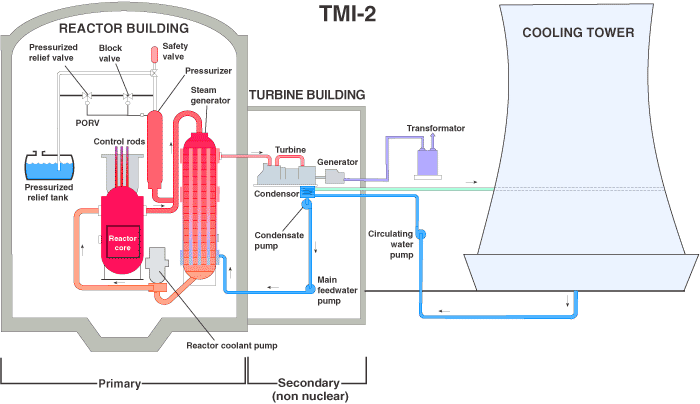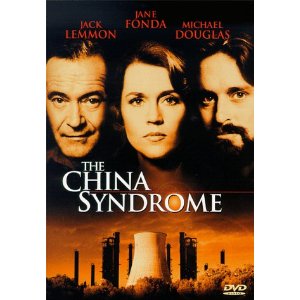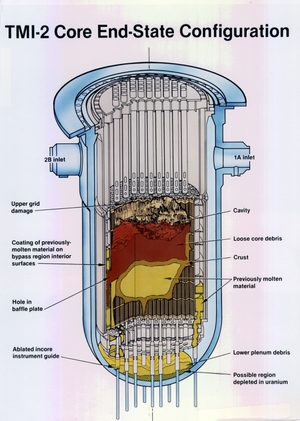Three Mile Island and the China Syndrome
The China Syndrome - The Hiroshima Syndrome blossoms in America with Three Mile Island
For nearly 35 years after the atomic destruction of Hiroshima and Nagasaki, the American public was largely ambivalent to the construction and operation of electric generating plants using nuclear reactors. The government assured everyone that nuclear power plants were safe, and almost everyone believed it. Politicians and government employees believed that the potential for a massive, toxic release of radioactive material from a civilian reactor was so unlikely that it really wasn't worth worrying about. A sense of nuclear power plant security permeated the whole of America. But, that would all suddenly change during the wee hours of the morning of a spring day along the Susquehanna River.
Early in the morning of March 28, 1979, a small valve on one of Three Mile Island's (TMI) reactor plant pressurizer systems stuck open. This single event rapidly resulted in a severe nuclear power plant accident causing a fuel-core meltdown. No one knew what the actual extent of core damage actually was nor the fact that nearly total melting had occurred, leaving the door open for unbridled speculative controversy. As a result, a torturous series of paranoiac exaggerations, "official" over-reactions, and the recent release of a popular Hollywood movie, led to abject panic with respect to the people in south-central Pennsylvania, if not to the whole of the American public at large. It also marked the beginning of the end for the expansion of nuclear power plants in America. What's worse, the Hiroshima Syndrome was amplified beyond all reasonable bounds, and inflicted America with psychological damage we continue to suffer, some three decades later.
What the operators "knew"

The technical/mechanical sequence of events that caused the accident, and the subsequent public events that made TMI a ten-day media circus, is well-documented. To summarize the technical; a stuck-open pressurizer relief valve (PORV) allowed the water level in the reactor to slowly drop to the point where the entire fuel cell was uncovered. Very early on into the accident, the reactor's neutron-absorbing control rods fully inserted (SCRAM), stopping the splitting of U-235 and Pu-239 atoms. However, the waste atoms in the fuel could produce roughly 5% of full-power heat for up to 36 hours after the chain reaction ended. Without water to carry this heat away, the TMI fuel cell over-heated. It was late in the afternoon of March 28 before the plant operators re-started the water flow into the reactor. By 8pm that evening, their efforts had re-immersed the severely-damaged fuel. The operators and the plant's government officials believed fuel melting had been avoided. Unknown to anyone at the time, at the point where the fuel was essentially in a dry state, the temperature became so great that the fuel cell melted before cooling water flow could be restarted. Because visual monitoring of the fuel's status was impossible, no one inside or outside TMI knew melting had happened.
Soon after the core was re-immersed in water, a bubble of hydrogen began to build up inside the reactor, above the damaged core. On the second day of the TMI accident, hydrogen was detected inside the reactor building surrounding the reactor itself, indicating to the operators that a hydrogen bubble existed inside the reactor. Pressure and temperature monitors in the outer "containment" structure (Reactor Building) showed some sudden, unexpected increases, indicating a hydrogen burn-off inside the massive structure. In order for hydrogen to burn or explode, there must be at least a tiny bit of oxygen mixed into it. There was certainly oxygen in the outer Reactor Building, but there was no oxygen inside the reactor. Knowing this, the operators at TMI diligently reported the reactor's hydrogen bubble to the Nuclear Regulatory Commission (NRC), unconcerned about the hydrogen bubble because there was no danger of an explosion inside the reactor. The plant operators also knew the water flow through the reactor would eventually dissipate the bubble. However, a few officials in Washington over-reacted and calculated the explosive potential of the theoretical amount of hydrogen in the bubble and reported their conclusion to their superiors, incorrectly assuming the bubble could explode and possibly rupture the reactor's six-inch thick, solid steel vessel.
What the rest of the world "knew"
When the federal Nuclear Regulatory Commission (NRC) erroneously reported there was a potentially explosive hydrogen bubble inside the reactor to the news media on the morning of March 31, jounalistic hell broke loose. In most parts of America, all television programming was interrupted to "follow" the "breaking" events at TMI, largely because of the "explosive" hydrogen bubble that threatened to destroy the reactor and unleash enormously toxic amounts of radioactive material into the atmosphere on an "unsuspecting public". That evening, America's most trusted News Anchor, Walter Cronkite, made the following, startling announcement, "The world has never known a day quite like today. It faced the considerable uncertainties and dangers of the worst nuclear power plant accident of the atomic age. And the horror tonight is that it could get much worse. The potential is there for the ultimate risk of meltdown at Three Mile Island....". Again, no one knew meltdown had already occurred.
By the time America had been shocked by Cronkite's words, the NRC discovered their mistaken assumption about the hydrogen bubble being explosive. Reporting this good news to the press literally fell on deaf ears. Not yet knowing of the NRC's admitted mistake himself, Governor Thornburgh of Pennsylvania suggested that pregnant women and women of child-bearing age within 50 miles downwind of TMI might consider leaving the area. This "suggestion" was entirely predicated on the no-safe-level hypothesis relative to low level radiation exposures. It spawned a mass voluntary evacuation of roughly 140,000 people. Realizing the communications network between the reactor operators, the NRC, the State of Pennsylvania, and the news media was in a massive state of confusion, the NRC's Head of Reactor Regulation in Washington, Harold Denton, flew to TMI and became the sole source of further information. Too little, too late. Panic had set in. Nobody believed anybody "official" any more. On April 1, President Jimmy Carter and Gov. Thornburgh visited TMI, with as much media coverage as they could muster, in the attempt to quell what had become a national panic. That didn't work either, mostly because the press repeatedly reminded everyone that the governor's "evacuation advisory" was still in effect. America remained on edge for another 5 days.
On April 6, the governor removed the evacuation advisory, and President Carter made an official "near meltdown" statement to the press. It was like saying everyone had breathed a collective sigh of relief. Meltdown itself had been narrowly avoided. In the confusion and informational turbulence of the TMI accident, nobody had the foggiest idea the President's statement about a near-meltdown was entirely wrong.
For the next five years, TMI was a regular news story across America. Anti-nuclear groups across the country filed numerous lawsuits effectively delaying anyone actually opening the reactor to see what happened to the fuel. Numerous cancer death scenarios proliferated, all based on the then-unquestioned no-safe-level theory, with the most frightening of these predictions getting the most news coverage. New developments seemed to arise almost every day, and dutifully reported in newspapers and on TV. Hoping to quell public fears concerning nuclear power plants, the NRC imposed a moratorium on building new nuclear plants, and required that those already under construction stop their work until regulations could be adequately revised to insure TMI could not happen again. Each and every change to the regulations was challenged in the courts, with almost every challenge broadcast on the evening news. Delays with completing the new plants extended into the better part of three years. The nuclear power death knell in America had been sounded.
Einstein's fears about the public confusing fallout with radiation also came to immediate fruition. News reports routinely called the radioactive releases from TMI "fallout". And, it wasn't only the press that made Einstein a prophet. Official reports released by the government concerning a wide realm of "additional cancer" estimates from the accident often made references to bomb fallout, as well! The image of the terrible effects bomb fallout had on the Japanese at Hiroshima immediately arose in most people's minds. The considerable differences between bomb fallout and reactor plant radiation were literally unknown to the public, but the government made the misleading linguistic connection none-the-less. Connecting the mental image of bomb fallout to the frightening specter of a near-meltdown only made a worst case accident with many, many innocent people dying, seem to be something inevitable. Added to this was the universally-believed theory of there being no safe level to even the most minuscule amounts of radiation, and the fear logically elevated to one of phobic reaction to anything associated with radiation itself. The long held, deeply ingrained fear and loathing of nuclear weaponry which had been logically associated with power plant reactors suddenly erupted out of the collective subconsciousness of the public with the suddenness of a volcanic eruption. The Hiroshima Syndrome had been effectively elevated to a level of national psychosis. Unfortunately, "official" reports and references concerning the potential health impacts of radioactive releases from nuclear plants continue to reference bomb fallout and the no-safe-level theory to this day!
China Syndrome
On March 14, exactly two weeks before the TMI accident began, a popular movie was released from Hollywood starring two well-loved movie stars, Jane Fonda and Jack Lemmon. It was called China Syndrome.

In the movie, a nuclear power plant in California experiences some nebulous sort of serious malfunction, and comes very close to a full core meltdown. Although exactly what the phrase "China Syndrome" meant was never clearly explained, the plot suggested that such an event would potentially kill thousands of unsuspecting Americans when the molten core would burn itself deep into the Earth‘s crust and spew out its invisible toxic radioactive cloud. The movie was a box office smash, but considered "just science-fiction" by most who saw it... before TMI happened. For all intents and purposes, very few people in America had heard the term "meltdown" or otherwise had any idea what the term meant before seeing the movie. But the similarities between the plot of the movie and the confusing, often terrifying reports coming out of TMI for the first five days of the accident, were simply too great for the public to ignore. Because of the accident at TMI, the movie's title, "China Syndrome", was suddenly on every-one's lips. Not only did the misconception about Uranium being an explosive continue to exist in the public mind, but now there was a new addition to that fear…meltdown. If a "near meltdown" was a terrible accident, how bad would a real meltdown be? TMI would have been a public relations disaster without the movie, but China Syndrome gave America a phrase of fear that made the TMI accident seem nigh-apocalyptic. Further, China Syndrome added its own level of inflation to the Hiroshima Syndrome, as well.
What really happened?
Legal battles kept the damaged reactor at TMI from being opened and internally inspected until 1984, when tiny underwater cameras were lowered into the reactor vessel by way of holes bored through a rather thick debris bed, and a thick "crust" below that. The crust inside the reactor was puzzling because no one had ever seen such a thing before. Eventually the cameras were turned on, near what should have been the top of the fuel cells, but there was nothing. Probing a few feet deeper into the core area, they found…nothing. Near the bottom of the center of what used to be the core, the inspectors found some gnarled chunks of severely deformed fuel cells. At this point, it was obvious. TMI wasn't a "near meltdown" at all. This was preliminary evidence of a severe meltdown. Over the next several weeks while using the underwater cameras, a complete inspection showed that 52% of the uranium fuel, in the center of the cylindrical core, had completely melted. Another 40% of the fuel located around the core's center had partially melted. Only the ring of fuel cells on the periphery of the core, about 8% of the total, were "merely" heat damaged; meaning they did not completely or otherwise partially melt.

Now what? President Carter had assured America that TMI was a near meltdown. Carter's words had to be at least modified. This could result in even more public distrust of the government and generally a lot of bad press. So the government waited. In 1986, the reactor's damaged fuel was to be removed and all subsequent analytical work would be performed ad nauseum until all conclusions met with a high degree of scientific confidence. The plan was that a report of a "partial meltdown" at TMI would be released to the press concurrent with the de-fueling of the reactor. As fate would have it, on the same day the "partial meltdown" story was released to the press, the Chernobyl's accident was discovered by surveillance satellites. As a result, the press statement saying TMI was a "partial meltdown" was released to the world…and relegated to be no more than a journalistic "so what?". The press had a bigger nuclear fish to fry. The Chernobyl disaster was all over the front pages of newspapers around the world, and the lead story on the evening news. The "new" truth about the TMI accident was instantly a non-issue to the popular press, and virtually unknown to the people of America.
As it turns out, the most recent public statement by the NRC on the TMI accident in August, 2009, finally dropped the misleading "partial meltdown" phrase, "Because adequate cooling was not available, the nuclear fuel overheated to the point at which the zirconium cladding (the long metal tubes which hold the nuclear fuel pellets) ruptured and the fuel pellets began to melt. It was later found that about one-half of the core melted during the early stages of the accident. Although the TMI-2 plant suffered a severe core meltdown, the most dangerous kind of nuclear power accident, it did not produce the worst-case consequences that reactor experts had long feared."
TMI was a severe meltdown, without a doubt. But, the fuel had not magically coagulated into a super-hot, glowing mass, burning its way through the reactor's 6 inches of solid steel and 8-10 feet of steel reinforced concrete beneath, burrowing itself down into the Earth's crust, spewing invisible radioactive fallout everywhere, causing thousands and thousands of radiation-related casualties predicted in the movie China Syndrome. No nuclear detonation, either. Unexpectedly, TMI had proved that China Syndrome was a fiction. Unfortunately, it took the American government nearly three decades to actually say it.
Was anyone hurt because of TMI?
It has been more than 30 years since the high drama of the Three Mile Island accident. The accident itself produced no physical injuries or severe radiation exposures to anyone. But, what about the long term effects on the people exposed to TMI's radioactive releases? Detailed follow-up studies of cancer mortality covering the three decades since the accident have statistically shown no negative health effects as a result of radiation exposure. In fact, cancer death rates in the TMI-exposed population have been a bit less than the unexposed public, and the medical records of the exposed group have been slightly better than the unexposed group. Unquestionably, no one has died as a result of TMI radiation, and the accident's radioactive releases have not caused any radiation-related sicknesses either. The no-safe-level hypothesis cannot account for these statistics, but the rather recent discovery of radiation exposure being an hormetic phenomena can!
Regardless, people have been hurt in the three decades since TMI, and the reason is something more subtle and pervasive than radiation itself. The negative long-term psychological damage of the TMI-amplified Hiroshima Syndrome on the thousands of people who lived near the power plant at the time of the accident has not been assessed. Neither has its negative long-term mental health impact on America at large. And, what about the world-wide impact of America's continued reliance on burning fossil fuels for the past 3 decades, and its contribution to global climate change? If anyone has suffered long-term sickness...if anyone has died as a result of TMI...the culprit is clearly the Hiroshima Syndrome.
Was TMI the worst thing that could possibly happen to a power plant reactor? Perhaps? Probably? The answer to this question is a matter of personal opinion. But as far as technological failures, mechanical malfunctions, operational errors, confusing communications, and unrealistic exaggerations are concerned, TMI probably is the worst thing that could happen to a nuclear power plant using water to slow down its neutrons…the worst thing that could happen anywhere other than in the land of the now-defunct USSR.
Summation:
1. The Three Mile Island (TMI) accident was a severe meltdown.
2. There have been no negative health effects due to the relatively trivial radiation releases from the TMI accident.
3. The only negative long-term health effect from TMI has been mass psychosis caused by the Hiroshima Syndrome .
4. China Syndrome is a fiction.
References:
- Three Mile Island Emergency : Timeline; Dickinson College Virtual Museum;
http://www.threemileisland.org/virtual_museum/index.html; 2007 - Backgrounder on the Three Mile Island Accident; U. S. Nuclear Regulatory Commission;
http://www.nrc.gov/reading-rm/doc-collections/fact-sheets/3mile-isle.html; August 11, 2009 - Three Mile Island Accident; World Nuclear Association;
http://www.world-nuclear.org/info/inf36.html; updated January, 2010 - Mondaut, Patrick; Meltdown at Three Mile Island; Super 70's.com;
http://www.super70s.com/Super70s/News/1979/March/28-Three_Mile_Island.asp; 2010 - Gov. Thornburgh, Pres. Carter, and Harold Denton; Three Mile Island Press Conference; http://www.library.pitt.edu/thornburgh/transcripts/DTA369.pdf; April, 1979
- The China Syndrome; Super 70's.com;
http://www.super70s.com/Super70s/Movies/1979/China_Syndrome.asp
Next - The Chernobyl Disaster https://www.hiroshimasyndrome.com/chernobyl.html

